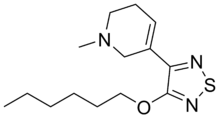キサノメリン
キサノメリン(Xanomeline)は、M1及びM4に選択性があるが[1][2][3][4]、M5にも活性があることが知られているムスカリン性アセチルコリン受容体のアゴニストである[5]。胃腸への副作用はあるものの、アルツハイマー病と統合失調症の両方、特に認知と陰性症状の両方について研究が行われているが[6]、臨床的な副作用により中断率が高くなっている[7][8]。これを除けば、キサノメリンは統合失調症の症状に効果をある程度効果を示す。また、ヒトにおいて、学習やワーキングメモリを改善する効果が示されている[9]。
 | |
| IUPAC命名法による物質名 | |
|---|---|
| |
| 識別 | |
| CAS番号 | 131986-45-3 |
| ATCコード | None |
| PubChem | CID: 60809 |
| ChemSpider | 54797 |
| UNII |
9ORI6L73CJ |
| KEGG | D06330 |
| ChEMBL | CHEMBL21536 |
| 化学的データ | |
| 化学式 | C14H23N3OS |
| 分子量 | 281.42 g/mol |
| |
統合失調症の治療薬として、キサノメリンに副作用止めとして末梢性ムスカリン受容体拮抗薬であるトロスピウムを配合した合剤である「KarXT」がカルナ・セラピューティクスにより開発中であり、2023年11月29日、カルナ・セラピューティクスはFDAが正式に審査を開始し、審査終了目標日(PDUFA date)が2024年9月26日に定められたとと発表した[10]。
関連項目 編集
出典 編集
- ^ Farde L, Suhara T, Halldin C, et al. (1996). “PET study of the M1-agonists [11C]xanomeline and [11C]butylthio-TZTP in monkey and man”. Dementia (Basel, Switzerland) 7 (4): 187–95. PMID 8835881.
- ^ Jakubík J, Michal P, Machová E, Dolezal V (2008). “Importance and prospects for design of selective muscarinic agonists”. Physiological Research / Academia Scientiarum Bohemoslovaca 57 Suppl 3: S39–47. PMID 18481916.
- ^ Woolley ML, Carter HJ, Gartlon JE, Watson JM, Dawson LA (January 2009). “Attenuation of amphetamine-induced activity by the non-selective muscarinic receptor agonist, xanomeline, is absent in muscarinic M4 receptor knockout mice and attenuated in muscarinic M1 receptor knockout mice”. European Journal of Pharmacology 603 (1-3): 147–9. doi:10.1016/j.ejphar.2008.12.020. PMID 19111716.
- ^ Heinrich JN, Butera JA, Carrick T, et al. (March 2009). “Pharmacological comparison of muscarinic ligands: historical versus more recent muscarinic M1-preferring receptor agonists”. European Journal of Pharmacology 605 (1-3): 53–6. doi:10.1016/j.ejphar.2008.12.044. PMID 19168056.
- ^ Grant MK, El-Fakahany EE (October 2005). “Persistent binding and functional antagonism by xanomeline at the muscarinic M5 receptor”. The Journal of Pharmacology and Experimental Therapeutics 315 (1): 313–9. doi:10.1124/jpet.105.090134. PMID 16002459.
- ^ Lieberman JA, Javitch JA, Moore H (August 2008). “Cholinergic agonists as novel treatments for schizophrenia: the promise of rational drug development for psychiatry”. The American Journal of Psychiatry 165 (8): 931–6. doi:10.1176/appi.ajp.2008.08050769. PMID 18676593.
- ^ Messer WS (2002). “The utility of muscarinic agonists in the treatment of Alzheimer's disease”. Journal of Molecular Neuroscience : MN 19 (1-2): 187–93. doi:10.1007/s12031-002-0031-5. PMID 12212779.
- ^ Mirza NR, Peters D, Sparks RG (2003). “Xanomeline and the antipsychotic potential of muscarinic receptor subtype selective agonists”. CNS Drug Reviews 9 (2): 159–86. doi:10.1111/j.1527-3458.2003.tb00247.x. PMID 12847557.
- ^ Shekhar A, Potter WZ, Lightfoot J, et al. (August 2008). “Selective muscarinic receptor agonist xanomeline as a novel treatment approach for schizophrenia”. The American Journal of Psychiatry 165 (8): 1033–9. doi:10.1176/appi.ajp.2008.06091591. PMID 18593778.
- ^ “FDA kicks off review of Karuna’s schizophrenia drug KarXT”. pharmaphorum. pharmaphorum (2023年11月29日). 2023年12月13日閲覧。